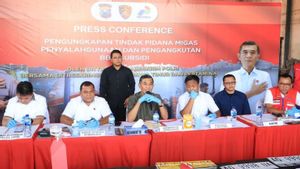JAKARTA - BPJS Kesehatan President Director Ghufron Mukti is still questioning the concept offered through the Standard Inpatient Class (KRIS) policy.
"That's why we are still waiting because the concept is that we are still questioning it," said Ghufron Mukti at the BPJS Health Program and Finance Management Public Expose for the 2022 Financial Year in Jakarta, Antara, Tuesday, July 18.
National Health Insurance (JKN) is still in accordance with the mechanism of the program being carried out, including the financing mechanism.
"JKN is already at the right destination. If you want to change it, it's just a small thing that is corrected, not a basic and unclear nature in the future," said Ghufron.
Asked about the influence of KRIS on BPJS Kesehatan participant contributions, Ghufron said he was still waiting for the results of the trial from the program to find out more about the rules to be enforced.
"I want to ask, what will KRIS look like? Are the dues the same, the rich and the poor the same or what?," he said.
The government together with all relevant stakeholders continue to finalize the KRIS implementation plan in the JKN – Healthy Indonesia Card (KIS) Program.
Since September 1, 2022, the policy has been tested in four vertical hospitals under the Ministry of Health (Kemenkes), namely Dr. Tadjuddin Chalid Makassar Hospital, Dr Johannes Leimena Hospital Ambon, Surakarta Hospital, and Dr Rivai Abdullah Hospital Palembang.
KRIS is made based on the principles of social insurance and equity principles. The hope is that every JKN-KIS participant has something in common in obtaining services in accordance with medical needs that are not bound by the class or amount of dues paid.
There are 12 criteria for KRIS that have been set, namely building materials in hospitals that do not have high porosity, air ventilation meets the requirements, good room lighting, completeness of beds (at least two boxes of electrical contact, nurses of calls connected to nurses).
Furthermore, one health worker per bed is available, can maintain a stable room temperature of 20--26 degrees Celsius, a divided room based on gender, age, and type of disease, a treatment room density of 2.4 meters, a minimum area per bed of 10 square meters, between beds of at least 1.5 meters, the maximum number of beds per room of four units, and beds can be adjusted 200 x 90 x 50--80cm.
In addition, curtains or rail partitions are immersed or attached to porous ceilings and materials, indoor bathrooms, bathrooms according to accessibility standards, and oxygen outlets are available.
اقرأ أيضا:
The English, Chinese, Japanese, Arabic, and French versions are automatically generated by the AI. So there may still be inaccuracies in translating, please always see Indonesian as our main language. (system supported by DigitalSiber.id)
العلامات الأكثر شيوعًا
#Prabowo Subianto #السنة الجديدة #pdip #هاستو كريستيانتو #ناتارو #عيد الميلادجمع
28 Desember 2024, 12:00
28 Desember 2024, 08:10


















